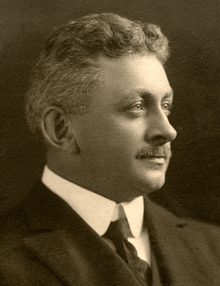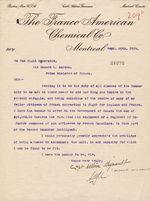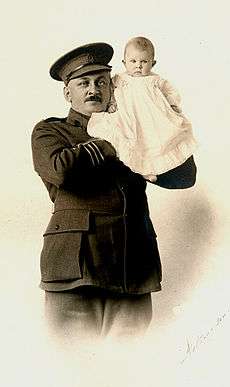Arthur Mignault
| Arthur Mignault | |
|---|---|
 Colonel Arthur Mignault | |
| Born |
29 September 1865 St-Denis, Canada East |
| Died |
26 April 1937 (aged 71) Montreal, Quebec, Canada |
| Buried at | Cimetière Notre-Dame-des-Neiges |
| Allegiance |
|
| Service/branch |
|
| Years of service | 1909–1918 |
| Rank | Honorary Brigadier General |
| Unit | Royal Canadian Army Medical Corps |
| Awards |
|
| Spouse(s) | Béatrice Boyer |
| Relations |
Arthur Boyer, father-in-law Henri Julien, friend |
Arthur Mignault, MD (29 September 1865 – 26 April 1937) was a French Canadian pharmaceutical entrepreneur, physician and colonel of the Royal Canadian Army Medical Corps, serving in the First World War. He is the founder[1] of the Royal 22e Régiment, today the largest regiment of the Canadian Army.[2]
Early life
Mignault was born in St-Denis, Canada East[3][4][5] in 1865.[6][note 1] He graduated from medical school at the Université de Montréal in 1888,[8] leaving shortly thereafter to practice in Maine. Upon returning to Montreal in 1896, Mignault started a career in the pharmaceutics business. He made his fortune by selling what he marketed as the petites pilules rouges (little red pills),[9] a drug against anemia, intended for women's use. A sports enthusiast and a horse racing amateur, he cofounded in 1901 the first French Canadian polo club.[10]
Mignault was a friend of artist and cartoonist Henri Julien. The latter's well-known gouache painting Le vieux de '37 seems to have been sponsored by Mignault, and as of 2009, the work is still in the family's personal collection. It has been hypothesized[11] that the man pictured be Mignault's grandfather, Joseph-Édouard Mignault, a notary from Arthur's hometown who participated[12] in the Battle of Saint-Denis of 1837 as a Patriote quartermaster.
Mignault gained notoriety as a philanthropist in 1909, as he offered some of his lands in downtown Montreal to establish a playground for poverty-stricken children.
In 1912, he married Béatrice Boyer, daughter of Canadian senator Arthur Boyer, and granddaughter of the wealthy Quebec land owner Louis Boyer.[13] They had a single daughter, Valérie, born in 1914.
Military career
In 1909, Mignault enlisted with the 65th Regiment "Carabiniers Mont-Royal" (now Les Fusiliers Mont-Royal) as surgeon lieutenant.

Founding of French Canadian army units
In 1914, Mignault communicated with Prime Minister Robert Borden to propose the establishment of a solely French Canadian battalion within the Canadian Expeditionary Force (CEF). According to Mignault, this would allow Canadians of French extraction to circumvent the language barrier of the English-speaking battalions. To support his cause, Mignault offered the significant amount of C$50,000.[14] He expressed the desire to accompany the unit overseas, should it be formed. Despite Canada's relatively modest population, Borden had recently committed his country into providing half a million soldiers for the Allied cause. Realizing the difficulty of raising such an army on a voluntary basis, Borden conceded.[15] Accordingly, on 14 October 1914, the exclusively French Canadian 22nd Infantry Battalion, CEF, was formed.
Mignault proved himself right as his recruitment campaign turned out to be a considerable success. Through French Canadian newspapers and media hype, the ranks of the newly formed battalion were filled in less than a month. Shortly thereafter, content of his recent achievement, Mignault moved to personally finance two other French Canadian battalions, the 41st and the 57th. However, these two lesser-known units fell short of experienced French Canadian officers: most of them had already been moved from English-speaking units to the 22nd Battalion.[16]
Overseas

While Mignault soon realized that he would not be put in charge of a battalion by financing infantry units, as such was clearly his desire,[17] he opted to found and finance a medical unit.
By early spring 1915, Mignault had encouraged the Canadian government to settle down a solely French Canadian stationary hospital near the German frontlines in eastern France. He argued that such an establishment could improve Canadian medical implication on the Western Front, as French-speaking medical personnel would naturally better fit, within French lines, than their English counterparts. The government recognized the need to improve Canada's medical efficiency in France. The fourth Canadian Stationary Hospital would soon commence its recruitment campaign. Mignault was put in command, and was promoted to the rank of lieutenant colonel. By November 1915, Mignault, along with 100 men, had reached the commune of Saint-Cloud in suburban Paris, where the hospital would be deployed.
On 15 April 1916, a month after the first convoy of wounded French soldiers had arrived, French President Raymond Poincaré officially inaugurated the hospital. Upon meeting him, Poincaré opined that Mignault "looked Norman".[18] Several French figures attended the ceremony, namely the Canadian Minister of Overseas Military Forces, Sir George Perley, prominent historian and member of the Académie Française, Gabriel Hanotaux, chief of French medical service, Justin Godart, and High Commissioner of Canada in Paris, Philippe Roy.[19]
The hospital's capacity was initially set at 250 beds, but increasing cases of syphilis and gonorhea among French soldiers led to expand its capacity to a full 600. In prevision of increased activity, Stationary Hospital No. 4 was made and renamed General Hospital No. 8 of the Canadian Medical Corps. Simultaneously, Mignault was made colonel and first senior Canadian medical officer in Paris, which entrusted him as supervisor of the two French Canadian war hospitals in France.
However, of bold nature, Mignault did run into some trouble. In 1916, Canadian authorities had to unravel and discharge several goods and services he purchased without authorization of relevant French firms. Embarrassed, Canadian authorities considered convening Mignault to court-martial, but failed to follow through. He was however called back to Canada in November of that year.[20]
End of war
Upon his return home, Mignault was appointed in charge of military recruitment of French-speaking Canada. In spite of his humiliating dismissal from the field, he quite soon received several honours and distinctions. As Major General Sir Eugène Fiset congratulated him for his services in the name of the Canadian Ministry of Militia and Defence, France beset him the title of Knight of the Legion of Honour.[21]
Mignault was transferred to Canada's military reserve following the enactment of the conscription of 1917. Designated a federal recruiting agent at the beginning of that year, he pursued his mobilising activities among French Canadians.[22] Nevertheless, his military career came to a definite end on 15 September 1918, as he had entangled himself in another predicament with Canadian military authorities.[23]
Later life
Despite his expulsion from the army in 1918 and following the end of the war, Mignault continued to promote the military service to young French Canadian physicians.[24] In the years following the war, he cadged the title of Brigadier General to the medical corps, and saw his entreat refused time and again. Nonetheless, towards the end of his life, his services in World War I were indeed recognised, and, a month before his death in 1937, he was granted the title of Brigadier General. He was the first French Canadian to be promoted to such rank in the Canadian Medical Corps.[25]
Mignault died in Montreal[26] on 26 April 1937.[27]
Legacy
In 1989, in central Laval, a street was named Rue Arthur-Mignault in the doctor's honour.[28][29]
See also
Notes
References
- ↑ "Arthur Mignault – Les Fusiliers Mont-Royal". http://www.lesfusiliersmont-royal.com (in French). Association des Fusiliers Mont-Royal (1961 inc.). 13 May 2009. Archived from the original on 13 June 2013. Retrieved 16 May 2013.
L'histoire militaire canadienne se souvient surtout du Dr Arthur Mignault comme fondateur de l'actuel Royal 22e Régiment.
External link in|work=(help) - ↑ "Royal 22e Régiment – The Van Doos". vandoos.com. Retrieved 16 April 2013.
The Royal 22e Régiment is an infantry regiment, and the most famous francophone organization of the Canadian Forces. The regiment comprises three Regular Force battalions, two Primary Reserve battalions, and a band, making it the largest regiment in the army.
- ↑ Jodoin, J. (September 1865), Acte d'état civil de la paroisse de Saint-Denis-sur-Richelieu (in French), vingt-quatrième pamphlet, Saint-Denis-sur-Richelieu: Parish of Saint-Denis-sur-Richelieu, p. B-76
- ↑ "Associated Image(s)- Soldiers of the First World War – CEF – Library and Archives Canada". Library and Archives Canada. Retrieved 16 April 2013.
In what Town, Township or Parish, and in what Country were you born?....St-Denis Co St-Hyacinthe
- ↑ "Colonel Arthur Mignault". Canadian Great War Project. Retrieved 6 June 2013.
Place of birth: St. Denis, Quebec
- ↑ Jodoin, J. (September 1865), Acte d'état civil de la paroisse de Saint-Denis-sur-Richelieu (in French), vingt-quatrième feuillet, Saint-Denis-sur-Richelieu: Parish of Saint-Denis-sur-Richelieu, p. B-76
- ↑ "Associated Image(s)- Soldiers of the First World War – CEF – Library and Archives Canada". Library and Archives Canada. Retrieved 16 April 2013.
What is the date of your birth?....sept 29. 1866
- ↑ "Obituaries". Canadian Medical Association Journal. Canadian Medical Journal. 37 (1): 94. 1937. PMC 1562280
 .
. Dr. Arthur Mignault, of Montreal, died on April 26, 1937, aged seventy-one. He was a graduate of the University of Montreal (1888).
- ↑ Pépin, Carl. "La guerre des Canadiens français (1ère [sic] partie, 1914–1916)". Le blogue de Carl Pépin (in French). Retrieved 16 April 2013.
Le Dr. Arthur Mignault, qui avait fait fortune dans les "petites pillules rouges", le grand argentier du 22e bataillon à ses débuts.
- ↑ Gill, Pauline (2008). "VIII". Docteure Irma, T. 2: L'indomptable (in French). Québec Amérique. p. 343. ISBN 978-2-7644-0611-3. Retrieved 16 April 2013.
Amateur et propriétaire de chevaux de course, le docteur Arthur Mignault avait aussi cofondé, en 1901, le premier club de polo chez les Canadiens français
- ↑ St-Jean, France (2009). "5.2.3". Images du patriote : objets commémoratifs, intentions variables (PDF) (PhD) (in French). Université du Québec à Montréal. Retrieved 16 April 2013.
Nous émettons également comme hypothèse que l'aquarelle Un Vieux de '37, celle qui figure dans Henri Julien Album, pourrait être le portrait d'Edmond-Joseph-Édouard Mignault (....-1878) qui, au moment des rébellions de 1837–1838, exerçait la profession de notaire à Saint-Denis-sur-Richelieu et détenait une commission à la cour de circuit qui siégeait annuellement à Saint-Denis. Il aurait participé aux événements de 1837–1838 en appuyant, notamment, une résolution lors de l'assemblée de Saint-Ours, le 7 mai 1837 et, à la demande de Wolfred Nelson, en assurant l'intendance de la milice patriote lors de la bataille du 23 novembre 1837. Edmond-Joseph-Édouard Mignault est le grand-père d'Arthur Mignault
- ↑ Kyte, Elinor Sr. (1990). La série des batailles canadiennes no 7, la bataille de Saint-Denis (PDF) (in French). Toronto, Ontario: Balmuir Book Publishing Limited. p. 25. ISBN 0-919511-45-7. Retrieved 16 April 2013.
Le notaire de la localité, Joseph-Édouard Mignault, fut nommé quartier-maître par Nelson.
- ↑ http://www.nosorigines.qc.ca/GenealogieQuebec.aspx?genealogy=Migneault_Arthur&pid=274358&lng=en (page consulted on 11 January 2013)
- ↑ Le Rossignol, J.E. (April 1915), "Canada and the War", The Mid-West Quarterly (1913–1918), 2 (3): 274, archived from the original on 12 June 2013,
Meanwhile, active preparations were being made in Canada for a second contingent of 22,000 men, which should include a regiment exclusively composed of French Canadians, of whom about 2500 had already gone with the first contingent but had not been organized into units of their own. The proposal was received with great enthusiasm throughout the country. Dr. Arthur Mignault of Montreal made a gift of $50,000 toward the equipment, and offered his services as a surgeon.
- ↑ Desmond, Martin (2008). A Short History of Canada (Sixth ed.). Random House Digital, Inc. p. 237. ISBN 9781551991429.
Aware of a 1914 pledge of voluntary enlistment, the government did all it could. Borden finally put Arthur Mignault, a patriotic patent medicine maker, in charge of Quebec recruiting.
- ↑ Denton, Edgar (1980). Limits of Loyalty. Wilfrid Laurier Univ. Press. p. 89. ISBN 9780889200913.
Later, Colonel Mignault claimed that the press of volunteers forced Ottawa to authorize a 41st and a 57th Battalion for Quebec. [...] The 22nd battalion seemed to exhaust the available officer talent.
- ↑ Michel LITALIEN, Dans la tourmente, Outremont (Quebec), Athéna éditions, 2003, page 43. (French source)
- ↑ Jean-Charles BRACQ, L'évolution du Canada français, Montreal (Quebec), Librairie Beauchemin ltée, 1927, page 3. (French source; online version available here, on screen 22/488 : http://gallica.bnf.fr/ark:/12148/bpt6k5440947k/f22.image (page consulted on 12 January 2013))
- ↑ Michel LITALIEN, Dans la tourmente, Outremont (Quebec), Athéna éditions, 2003, page 50. (French source)
- ↑ Vennat, Pierre (25 February 2012). "La fondation du 22e bataillon (canadien français)". lequebecetlesguerres.org [dead archived site] (in French). Archived from the original on 14 October 2013. Retrieved 12 June 2013.
Malheureusement, les autorités militaires canadiennes eurent à démêler et à acquitter de nombreux comptes payés par Mignault pour l'achat d'équipement et de services qu'il avait faits sans autorisation auprès d'entreprises françaises. Embarrassées, les autorités militaires canadiennes songèrent même à l'amener en cour martiale, puis y renoncèrent, mais décidèrent de le rappeler au pays en novembre 1916.
- ↑ "Supplement to the London Gazette" (PDF). London Gazette. London: HM Government. 1 May 1917. p. 4156. Archived (PDF) from the original on 13 June 2013. Retrieved 13 June 2013.
Legion d'Honneur. Croix de Chevalier [...] Lieutenant – Colonel Arthur Mignault, Canadian Army Medical Corps
- ↑ "Du Military Service Act aux émeutes de Québec: l'effort de guerre canadien-français vu de France (1914–1918)". Le Bulletin d'histoire politique (in French). Association québécoise d'histoire politique. Archived from the original on 13 June 2013. Retrieved 13 June 2013.
La déception du consul est atténuée à la suite d'un entretien avec le colonel Arthur Mignault, qui s'occupe au Canada de recrutement en ce début de 1917. [...] La situation ne s'améliore pas au fur et à mesure qu'avance l'année 1917. De plus, le rapport de la Panouse en dit long sur les espoirs des autorités françaises relativement au travail d'Arthur Mignault, qui avait été nommé agent recruteur du gouvernement fédéral au début de cette même année.
- ↑ Vennat, Pierre (25 February 2012). "La fondation du 22e bataillon (canadien français)". lequebecetlesguerres.org [dead archived site] (in French). Archived from the original on 14 October 2013. Retrieved 12 June 2013.
Versé à la réserve des officiers en octobre 1917, [Mignault] poursuivit quand même son œuvre de recrutement auprès des Canadiens français. Mais, confronté à nouveau à des difficultés avec les autorités militaires, il fut licencié définitivement de l'armée le 15 septembre 1918.
- ↑ "Arthur Mignault – Les Fusiliers Mont-Royal". http://www.lesfusiliersmont-royal.com (in French). Association des Fusiliers Mont-Royal (1961 inc.). 13 May 2009. Archived from the original on 13 June 2013. Retrieved 13 June 2013.
Démobilisé en septembre 1918, il continuera, même après la guerre à faire la promotion du service militaire auprès des jeunes médecins canadiens-français.
External link in|work=(help) - ↑ "La fondation du 22e Bataillon (canadien-français) . Milguerres" (in French). Milguerres (blog). 24 November 2012. Archived from the original on 13 June 2013. Retrieved 13 June 2013.
Toutefois, même après la guerre, Arthur Mignault continua de faire la promotion du service militaire auprès des jeunes Canadiens français et fut finalement nommé brigadier général honoraire, le premier Canadien français promu à ce grade au sein du Corps médical de l'armée canadienne. Il mourut le 26 avril 1937.
- ↑ "Today in Canadian History, 1937". Montreal. 26 April 1938. p. 8. Retrieved 13 June 2013.
A French – Canadian doctor and patriot, Dr. Arthur Mignault, died at Montreal.
- ↑ Blanchard, E. (April 1937), Acte d'état civil de la paroisse de Notre-Dame-de-Montréal (in French), deux cent quarante-troisième feuillet, Montreal, Quebec, Canada: Parish of Notre-Dame-de-Montréal, p. 242
- ↑ Fiche descriptive
- ↑ rue arthur mignault – Google Maps
External links
- Historical article describing the formation of the Stationary Hospital No4
- Mignault's military service file at the online Canadian Great War Project
- Historical newspaper advertisement for Mignault's "Red pills against anemia"
- Mignault's obituary
- (French) Short review of a book, Dans la tourmente, relating the story of the two French Canadian hospitals in World War I France
- (French) Mignault's article on the website of the Fusillers Mont-Royal, the regiment which he joined by volunteering in the army in 1909.